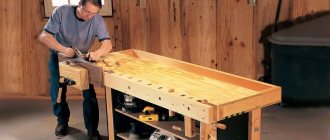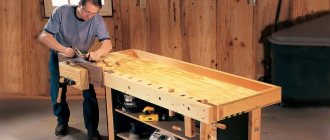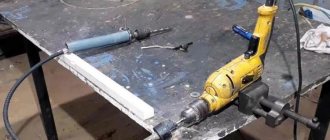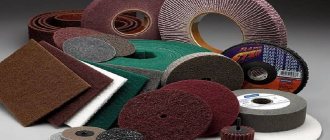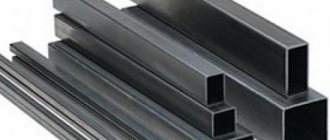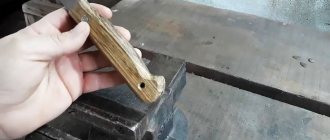Classic (solid) rivets
Classic rivets are the oldest and most reliable type of mechanical fastener. They require a pre-prepared hole and access to the connection from both sides. Before installation, a classic rivet consists of a cylindrical rod and a head at one end
Often classic rivets are simply called solid rivets. Solid rivets are classified by head shape and shank shape. The most commonly used solid rivets are round and flat heads, and sometimes also countersunk. In addition to completely solid rods, semi-tubular and tubular (hollow) rivet rods are also used to reduce the effort required to form the second head. The characteristics of a rivet joint, including strength, significantly depend on the type of rivet, its material and shape.
(picture 1).
Figure 1 - Various types of heads and shanks of solid rivets
When installing a solid rivet, a second head is formed from its rod by plastic deformation, which tightens the materials. Because the installed rivet has heads on both sides of the joint, it can carry tensile loads (along its axis), but is designed primarily to resist shear loads (perpendicular to the axis). Bolts and screws, on the other hand, are designed primarily to resist tensile loads [1].
The process for installing a rivet depends on the type of rivet shank. The rod of a solid rivet expands in the hole during riveting and completely fills it, which ensures a tight and reliable connection (Figure 2). In the case of a semi-tubular rivet, the back of the shank flares out and creates forces that press the materials together, while the diameter of the shank inside the hole remains virtually unchanged. Therefore, semi-tubular and tubular rivets are often used to create an axis between elements that rotate relative to each other.
In aluminum structures, aluminum rivets are used almost exclusively with cold installation, that is, without preheating them. They are used where reliability and safety are required, such as aircraft load-bearing structures and critical automotive components.
Figure 2 - Installation of a solid rivet
Types of accessories
Garment accessories include the following parts:
- Buttons.
- Hooks.
- Loops.
- Lightning.
- Blocks.
- Textile Velcro fasteners.
- Holniten are metal rivets. Most often used in denim clothing to secure stitching.
- Buckles.
- Eyelets. Durable metal or plastic fasteners are mainly used in leather goods.
- Rivets. There are utilitarian rivets - those that are used for clamping, fastening and fastening, and decorative ones. Very often, sewing accessories in clothing combine both roles.
The most popular materials for making fasteners and fasteners:
- Metal.
- Ceramics.
- Plastic.
If the part is not selected correctly, that is, without taking into account the characteristics of the fabric or leather, then the fittings simply will not cope with their functions. Then you will have to change the details on your clothes yourself so as not to throw expensive things into the far corners of your wardrobe.
Blind rivets
Types of Blind Rivets
The main feature of blind rivets is that these fasteners are installed and riveted on one working side using a pre-prepared hole. The designs and installation methods of blind rivets have many variations (Figure 3). However, only some of them are used for structural, load-bearing connections, the rest - for auxiliary, decorative purposes.
Figure 3 - Various types of blind rivets
What is riveting
The mechanical connection of parts using a series of rivets is called riveting, and the connection itself is called a riveted seam. It is used where it is inconvenient to weld parts or where non-weldable materials are joined. Not only metals are riveted, but also parts in clothing, accessories, etc. are connected in this way. But there it is more of a finishing touch than a loaded connection. So next we will talk about riveting in construction or home improvement. In principle, you can use a screw connection instead of riveting, but bolts and nuts are more expensive, and their installation takes longer.
This is what a rivet joint looks like
If we talk about installing fences made of corrugated sheets, rivets are more reliable, since they can only be removed by drilling out the fasteners. When installing screws or self-tapping screws, they can be unscrewed and both metal and hardware can be removed. In some cases, riveting is more convenient when installing a roof made of corrugated sheets or metal tiles. On the roof, installing screw connections is problematic and time consuming. But rivets, and with a good tool, can be done in an hour or even less.
Most common use in private households
How are parts connected using rivets? The rivet is installed in the prepared through hole. It has a head that rests on the material and the rod. During the riveting process, the end of the rod is flattened, changing shape under the influence of force. Therefore, ductile metals are used for these hardware.
Advantages of threaded rivets
- Simple installation technology.
- Possibility of reliable fastening of parts made of materials of increased fragility or low thickness (for example, sheet metal). The threaded rivet practically does not cause their deformation.
- If the total thickness of the connected samples exceeds the length of the fastening element, then the so-called one-sided fixation is performed, without a through passage. At the same time, the quality of bonding does not deteriorate.
Operating principle
A reliable connection at the installation site is ensured by the thread, which in nut samples is located on the inner surface, in bolted samples - on the outer surface of the crushed part.
Standard (blind) rivets
The main type of blind rivets that are used as structural fasteners are the breakaway blind rivets. We call them “blind rivets”
Standards and terms
In the Russian version of the international ISO standard, GOST R ISO 14588-2005, the official general name for all such rivets is: “blind rivets” (Figure 4). In the English version of the DIN 7337 standard, which has already been replaced by European (international) standards, this type of rivet was called “break mandrel blind rivets”, that is, “blind rivets with a tear-off core.” The American industry standard IFI 114, which was the first standard for such rivets, calls them “break mandrel rivets.” In practice and, often, in technical literature, these rivets are called “blind rivets”.
Figure 4 — Terms according to GOST R ISO 14588-2005:
1 — body of a “blind” rivet, 2 — end of a “blind” rivet, 3 — head of a “blind” rivet, 4 — shank of a “blind” rivet, 5 — core of a “blind” rivet, 6 — core, 7 — head of a core, 8 - core separation zone, 9 - core shank, 10 - core end.
Advantages of blind rivets
The three main reasons for using blind rivets are:
- Low installation cost. Other methods of joining materials—welding, screws, bolts and nuts, and solid rivets—require more human labor.
- Manifold. Blind rivets are available in many types, sizes and material combinations to suit specific design requirements.
- Reliability. A correctly selected and installed blind rivet can withstand high mechanical loads and harsh climatic influences.
Limitations of blind rivets
However, blind rivets have their limitations:
- The strength of rivets is limited by the strength characteristics of the materials used in it and the features of its hollow shape.
- Can only be used for joining relatively thin materials.
Installation of blind rivets
Blind - blind - rivets are installed in a tight hole that passes through the materials being joined (steps 1 and 2) - Figure 5. A rivet tool, called a riveter, grabs the tail of the core and pulls it towards itself, while holding the rivet in place (step 3 ). As the core is pulled, it deforms the rivet and forms the back, blind head of the rivet. At a certain moment, the core breaks off and part of it, together with the head, remains in the rivet (step 4). The rivet head formed at the back of the joint firmly presses the materials together.
Core breaking force
The force required to tear off the core is given by the amount of deformation required to form the rear head of the rivet and the diameter of the groove (notch) on the core. The core rupture force is set in such a way that:
- firstly, to avoid creating too much clamping force, which could damage the materials being joined, and
- secondly, its size was sufficient to perform a tight connection of materials.
Installation process
The algorithm for installing a threaded element can hardly be called overwhelming, but it is important to know certain nuances. If possible, it is better to use a factory riveter
If desired, you can assemble it yourself; one option will be discussed below. The first step is to determine the type of metal on which the rivet will be installed. Next, you need to know what the diameter of the bolt or module that will be fixed thanks to this rivet is. According to the specified diameter, the appropriate rivet is selected. Its outer diameter is measured and a drill is selected that will be one tenth in diameter larger than the rivet. This is necessary so that the latter fits into place without much effort or obstacles.
Electric or cordless drill. The metal is drilled in the required location. After this, the fastening element is inserted into the seat. If it needs to be placed in a certain position, then it is better to hold it with your hands. For hexagonal holes, you can use special punches if we are talking about thin metal. If the thickness of the metal is greater than the length of the fastener, then the hole must be drilled a little deeper than the fastener, but there is no need to make a through penetration. After this, a rivet maker core is selected that fits the thread to the element being installed. The handles are brought together or the bolt is rotated so that part of the rivet is deformed and fixed in the hole.
You should not apply too much force, as you can tear off the thread, which will later be used to fix the required part. It is necessary to ensure that the rivet is installed in the required position. After this, you can fix the required product using a screw or bolt.
Rivet connection thickness
Blind rivets are designed to join together materials with a specified overall thickness. The amount of deformation of the rivet body that occurs during its upsetting depends on this thickness (Figure 6).
Figure 6—Gripping a rivet connection
If the rivet is too long, there will be too much rivet material left on the blind side of the joint and more force will be required to break the core.
If the rivet is too short, there may not be enough rivet material on the "blind" side of the joint to ensure a tight connection between the materials.
Before the purchase
The use of rivets is always determined by three important nuances. Firstly, the strength of the connection plays a paramount role. Secondly, check what equipment you have and what components are suitable for it. And thirdly, understand the economic feasibility of the work and planned purchases
In any activity, no matter what materials you fasten and no matter what connectors you use, it is always important to remember that any rivet material has its own viscosity and plasticity, on the basis of which the algorithm for the operation of such a connection is based. Rivets are ALWAYS made of copper, low-carbon steel or aluminum alloys that are easily deformed
Carefully study the types of rivets when planning your work.
Threaded rivets
Let's move on to threaded rivets. Working with them is the most universal way to connect the constituent elements of a structure. The types of threaded rivets are varied, but the essence is the same. The algorithm is simple and ingenious: the rivet is screwed onto the “mandrel” of the riveter, inserted into the hole, and fixes the materials to be joined. In this case, the rivet is deformed, forming a reliable connection that firmly holds the individual parts during vibration and movement. The most important advantage is the low probability of damage to the parts being connected during riveting, which experience virtually no stress, are not scratched or wrinkled. Therefore, threaded rivets are used in household appliances, car cladding and interior decoration. Such components are made of aluminum, steel, and stainless steel. Types of threaded rivets, their features and composition are always indicated on the packaging.
Blind rivets
Another well-known type of rivets is blind rivets. They are cheaper than threaded ones, they are easier and faster to deal with, because they are used where it is necessary to secure a sheet of metal with hundreds or even thousands of rivets. Types of blind rivets differ mainly in the model of the collar. This is the name given to the edges of the “cap” located on the body of the rivet. Different types of blind rivets are usually made of steel, stainless steel, aluminum, and copper. Unlike the previous type, the sleeve is deformed thanks to a rod that is pressed into the sleeve, forming a rigid connection. The main advantage of these components is their high speed and ease of operation.
Regular rivets
The classic rivet is the most common hardware for riveting metal sheets, known since ancient times. In our country, driven rivets were fixed by GOST requirements back in the Soviet years. They are widely used in construction and in general in all areas associated with the presence of high loads on metal structures, since such rivets can connect sheets thicker than 30 mm. However, installation of these hardware is only possible taking into account the presence of support on the side opposite the plane of the connection, since this compensates for the impact load during fastening of the rivet.
The algorithm of actions is as follows:
- Future connections are being outlined.
- Sheet material is fixed with clamps or other means. Sometimes welding takes place. The extreme points are drilled first. The rivets are inserted so that the head is on the opposite side of the surface being joined.
- Actually, the process of riveting itself using a hammer or a special striker, in which the shank is flattened into a second head.
During the process, be sure to check with GOST, since a rivet body that is too thin may not completely fill the hole, which can lead to breakage of the connections under a cutting lateral load. A shank that is too long can also damage the structure, as the metal will be subject to improper deformation. There are brands of rivets that must be heated to a high temperature to increase ductility. Also, many rivets are treated with special compounds that prevent electromechanical corrosion. Please read the packaging carefully before purchasing.
Types of blind rivet heads
Blind rivets have several types of heads (Figure 7). Flush heads are designed for applications where the rivets must not extend beyond the plane of the surface. Wide heads are used for fastening softer materials to increase the contact area.
Figure 7 - Main types of heads
a - standard, b - hidden, c - wide
Main characteristics of fasteners
From the point of view of choosing this hardware, the main characteristic is size. Several parameters are taken into account, including the diameter of the rod. It can range from 1 to 36 mm with a length from 2 to 180 mm. However, you should not think that greater thickness is directly related to the strength of the rivet. Steel rod parts with a thickness of 10 mm can be much stronger than copper tubular elements, the diameter of which exceeds 20 mm. However, much depends on the nature of the loads applied - sometimes it is more profitable to use thin-walled tubular parts.
Models of rivets with a low semicircular head have a small range of thickness indicators - from 1 to 10 mm, and the length in this case varies from 4 to 80 mm. Products with a flat head have a thickness ranging from 2-36 mm with a length of 4-180 mm. The longest parts are semi-secret types of rivets that can be used in niches with a depth of about 200 mm.
Materials of rods and cores
Blind rivets have earned their popularity due to their ease of installation and the variety of shapes and materials used. The use of blind rivets in a wide variety of industrial and construction areas creates a need for rivets made from various types of materials.
Typically, the deciding factors when selecting materials for the components of a blind rivet—the rivet itself and the core—are strength, corrosion resistance, and the materials that will be joined by the rivet.
Materials of rods and cores:
- Aluminum-magnesium alloys (5xxx series): AlMg2.5; AlMg3, AlMg5.
- Galvanized carbon steel.
- 304 or 316 stainless steels.
Aluminum rivet sizes
What determines the choice of the size of a particular rivet? Several factors play an important role here: the type and properties of the parts being connected, the characteristics of the load, and the location of the hardware.
There is a generally accepted rule according to which hardware is chosen:
- The diameter of the rivet must exceed the thickness of the products being connected by at least 2.5-3 times.
- If the structure is subject to heavy loads, then the diameter of the rivet cannot be less than 2.5 millimeters.
Another way to determine the diameter of the rivet:
- You simply multiply the thickness of the sheathing by three.
- The diameter of the hardware is the next value after the obtained result.
- For example, the thickness of our cladding is 2 mm.
- Then 2.0 x 3 = 6 mm. That is, we will choose a rivet with a diameter of 6.2 mm.
Always choose rivets from trusted manufacturers. They will not risk their reputation and skimp on the quality of their products.
Galvanic corrosion on rivets
When dissimilar metals are in contact in the presence of some electrolyte, they undergo galvanic corrosion, with one metal corroding more quickly and the other more slowly.
The rate of corrosion depends on:
- differences in chemical potentials of metals;
- degree of electrical conductivity of the electrolyte and
- relative sizes of areas of contacting metals.
Blind rivets can be used with a variety of materials such as aluminum, stainless steel, mild steel, galvanized steel and copper. When using rivets in humid, chemically contaminated and marine atmospheres, measures must be taken to minimize galvanic corrosion:
- avoid the formation of a joint from dissimilar metals by correctly selecting the material of the rivet body;
- install a barrier between dissimilar materials, for example, in the form of a layer of paint, a plastic washer or a rubber seal;
- take measures to install drainage to allow water and other electrolytes to exit the structure.
How to choose a quality device
Why does the question of how to choose a riveter remain relevant? After all, despite the fact that the tool belongs to the manual category, it has a fairly high cost. To save money, many buyers decide to take a desperate step - they choose cheap models. As a result, the device fails very quickly, and it turns out that the money was wasted. You should also not buy expensive models, since it turns out that the tool will simply lie on a shelf in the garage most of the time. What to consider when choosing a manual riveter - there are the following nuances:
Device body material - do not buy plastic models. No matter how colorfully manufacturers and sellers describe them, such instruments are toys that are only suitable for children. You need to choose devices only from high-quality steel. Conscientious manufacturers indicate the type of steel used in the technical description. How much the tool weighs - a good thread riveter has the appropriate weight, which allows it to be used for connecting rivets with a diameter of 12-14 mm
Equipment - usually good and high-quality devices are sold complete with replaceable heads, as well as consumables
In addition, the devices are located in special plastic, metal or wooden cases, which simplifies not only their storage, but also transportation
The manufacturer is very important, since today different manufacturers with unknown reputations appear on the market. It is not recommended to tempt fate, so choose riveters from manufacturers such as Kraftool, Matrix, Gross, JTC, Stayer and others
This is interesting!
If you plan to use the tool frequently, then preference should be given to reinforced riveters.
They are more expensive than regular ones, but last longer and are designed specifically for long-term use. https://youtube.com/watch?v=LECRsPZ5oAA%3F
Drawing a conclusion about what types of manual riveters there are, it must be said that tie-type models are quite sufficient for home use. A threaded tool can also come in handy, but only if you plan to work with sheet steel. Proper storage and use will increase the service life of even a budget tool model.
Determining the length of a rivet with a broach
The length of the rivet with a broach can be determined using the following table, depending on the thickness of the materials being fastened (the manufacturer strongly does not recommend using rivets for riveting materials with a thickness less than the lower recommended limit and higher than the upper limit).
Threaded rivets
Threaded rivets, although they were invented almost simultaneously with broach rivets, became widespread only recently.
A threaded rivet is a hybrid of a hollow rivet and a nut, so the second name for such rivets is riveting nuts. In fact, there is no unity in the name - they are also called rivet nut, threaded rivet, rivet nut. This confusion with names is explained by the lack of an ISO or DIN standard for this type of fastener. The design feature of riveting nuts determines their dual purpose: with their help, you can either rivet sheet materials together or simply create threaded fastening points on thin-walled structural elements. The convenience of installing rivets is due to the absence of the need for access from the reverse side of the structure - the so-called “blind installation”. During installation, the already treated surface of the part, for example, with coating or painting, is not damaged.
According to the shape of the collar (head), riveting nuts are divided into:
- with a flat cylindrical collar (normal and reduced)
- with a hidden collar (normal and reduced)
According to their design, threaded rivets are divided into open - with a through hole, and blind - closed on one side.
According to the shape of the outer surface, threaded rivets are divided into:
- smooth
- corrugated
- hexagonal
- half-hexagonal
Installation, as in the case of tear-off (blow) rivets, is carried out using a specialized tool - pliers for riveting nuts - a riveter. We produce mechanical manual riveters and high-performance pneumatic riveters.
Features of the use of blind rivets
"Getting" the rivet
The technical characteristics of any blind rivet include minimum and maximum grip of the materials being fastened. In English it is called "grip". The maximum grip is the thickest combination of materials that a given rivet can hold together. The minimum grip is the thickness for which it is necessary to use a shorter rivet from the existing rivet size range. For example, a rivet with a minimum grip of 6 mm can be used for a smaller thickness, on the back side of the rivet there will be more body of the rivet than there should be for a normal size rivet (Figure 8, a) and b)). Sometimes this excessive length can interfere with adjacent structural parts. The so-called “multi-grip” rivets are in this sense more universal and can work in a wide grip range (Figure X, c)).
The so-called “multi-grip” rivets (Figure 8, c) are more universal in this sense and can work in a wide grip range, but they are more expensive.
Blind rivet hole size
The correct hole is very important to obtain maximum load-bearing capacity of the blind rivet. Even a small increase in size can lead to a sharp decrease in the load-bearing capacity of the rivets, both for breaking and shearing. Therefore, when installing rivets, use precisely specified drill sizes and a good drilling tool to avoid getting a broken hole, as shown in Figure 9b.
Figure 9 - a - normal, b - not allowed
DIY riveter
If the installation of threaded elements is required due to duty or work, then it makes sense to purchase a factory product that operates by hand force or based on a pneumatic mechanism. In most situations, the installation of such rivets is rarely required, so you can assemble the rivet gun yourself.
Bolt based
To assemble the entire structure, you will need a bolt similar to the one shown in the photo above. It can be taken from the crankshaft of a car engine. The diameter of the bolt must be such that a hole can be drilled inside it through which another bolt with a thread size that will match that used in the rivet will be inserted. The length of the second bolt must be at least 100 mm. The length of its thread should be as long as possible; if necessary, it can be additionally trimmed with a parallel tool.
Additionally, you will need a nut that will screw freely onto the thread of a bolt with a large diameter, as well as a collapsible bearing. The inner diameter of the bearing must be such that a long bolt, which will be used for clamping, can freely pass through it. The design is quite simple to assemble. To do this, you need to insert a long bolt inside a larger one in diameter. A nut is screwed onto the large bolt, and a collapsible bearing is placed onto the threads of the long bolt.
A rivet is screwed onto the long bolt and must be installed in the hole. You will need two keys to operate. One of them will hold the nut, and the second should rotate the bolt. You can simplify the task by welding a handle to the nut. The bolt rotates until the stop becomes significant. You shouldn't be too zealous. Once the result is achieved, you need to unscrew the long bolt. The bearing in this case is a stabilizer that prevents the bolt from biting inside the structure. There is a video about this riveter below.

